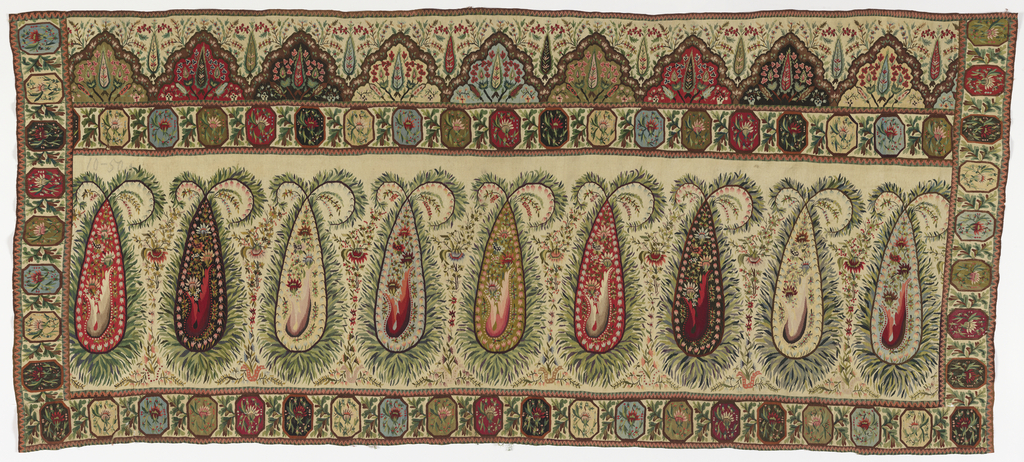This distinctive, fully reversible shawl border was handwoven in Russia in the early nineteenth century to be part of a Kashmir-style shawl. It was woven such that the intricate floral design is identical on both sides of the fabric.
Kashmir shawls were essential fashion accessories for stylish women of means in nineteenth-century Europe. Initially imported from India, they were superbly crafted and very expensive, and their popularity reflected the European aristocracy’s fascination with exotica from the East.
Authentic Kashmir shawls were handwoven using an even twill tapestry technique. Strong demand encouraged production of Kashmir-style shawls in several European countries. The French and British dominated European Kashmir-style shawl production using draw looms and jacquard looms. Mechanical looms allowed for large-scale production at low cost and enabled French and British manufacturers to successfully create and supply a mass market for shawls.
In contrast, Russian shawls were handwoven, a function of the essentially feudal nature of the Russian economy in the early nineteenth century. Production was centered in rural, estate-based cottage industries. The workforce consisted of enslaved serfs, many of who were very talented, highly skilled, and specially trained artisans.
In about 1806, several small, estate-based textile workshops in Russia began the handwoven production of Kashmir-style shawls. These workshops had previously produced pileless carpets using reversible, plain weave, dovetail tapestry construction. The Russians applied this technique with great success to shawls producing identical two-sided fabrics of astonishing complexity, such as in the Museum’s piece. The exquisitely detailed patterns are achieved with a very fine weave of approximately 40 ends per inch for the warp and approximately 100 ends per inch for the weft. Warp and weft thread ends were woven or darned back into the cloth to create a smooth finish on both sides.
These reversible shawls were unique to Russia in the first half of the nineteenth century. Fabrics woven by hand with the Kashmiri even twill technique or made on draw or jacquard looms are not reversible because of the long floats produced by the weave on the reverse side. Russian workshops were producing shawls with double-sided tapestry woven borders as early as 1808 while the French only began trying to make reversible shawls in 1827 and had little success until after 1850
For their designs, the Russians adapted the cone-like form or boteh motif that was ubiquitous in Kashmir-style shawls. Boteh comes from the Hindu word buta that means flower. The Russians’ boteh featured ornamentation based on realistic representations of native Russian flowers, creating strong, densely floral patterns that resembled other Russian textiles of the period.
Shawls from the Russian workshops won numerous prizes for their beautiful designs and fine craftsmanship at local and international exhibitions, including the Crystal Palace Exhibition of 1851 in London. After the abolition of serfdom in Russia in 1861, the cost of labor to handweave two sided shawl borders was prohibitive and the production of these remarkable textiles in Russia largely came to an end.
A Uniquely Two-Sided Shawl
